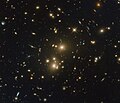File:Strings of homeless stars RXC J0232.2-4420.jpg

Original file (4,771 × 4,092 pixels, file size: 8.02 MB, MIME type: image/jpeg)
Summary
| DescriptionStrings of homeless stars RXC J0232.2-4420.jpg | English: This sparkling Picture of the Week features a massive galaxy cluster named RXC J0232.2-4420. This image was taken by Hubble’s Advanced Camera for Surveys and Wide-Field Camera 3 as part of an observing programme called RELICS (Reionization Lensing Cluster Survey). RELICS imaged 41 massive galaxy clusters with the aim of finding the brightest distant galaxies for the forthcoming NASA/ESA/CSA James Webb Space Telescope (JWST) to study.
The enormous gravitational influence of such clusters distorts the space around them in such a way that they can be used as giant cosmic lenses that magnify distant background galaxies. Studying some of the earliest galaxies in the Universe will tell us more about our cosmic origins. RXC J0232.2-4420 also featured in a study that focused on galaxy clusters that are especially luminous sources of X-rays . The study searched for diffuse light around the brightest galaxies in the clusters, among the most massive galaxies in the Universe. This diffuse light comes from intergalactic stars strung out between the constituent galaxies of the cluster and the aim of the study was to explore various theories for the origins of these stars. One theory is that that may have been stripped from their host galaxies during mergers and interactions. |
| Date | |
| Source | http://www.spacetelescope.org/images/potw1824a/ |
| Author | ESA/Hubble & NASA, RELICS |
Licensing
| ESA/Hubble images, videos and web texts are released by the ESA under the Creative Commons Attribution 4.0 International license and may on a non-exclusive basis be reproduced without fee provided they are clearly and visibly credited. Detailed conditions are below; see the ESA copyright statement for full information. For images created by NASA or on the hubblesite.org website, or for ESA/Hubble images on the esahubble.org site before 2009, use the {{PD-Hubble}} tag. Conditions:
Notes:
|
- You are free:
- to share – to copy, distribute and transmit the work
- to remix – to adapt the work
- Under the following conditions:
- attribution – You must give appropriate credit, provide a link to the license, and indicate if changes were made. You may do so in any reasonable manner, but not in any way that suggests the licensor endorses you or your use.
Captions
Items portrayed in this file
depicts
copyright status
copyrighted
copyright license
Creative Commons Attribution 4.0 International
inception
11 June 2018
File history
Click on a date/time to view the file as it appeared at that time.
| Date/Time | Thumbnail | Dimensions | User | Comment | |
|---|---|---|---|---|---|
| current | 09:00, 11 June 2018 |  | 4,771 × 4,092 (8.02 MB) | Jmencisom | User created page with UploadWizard |
File usage
The following page uses this file:
Global file usage
The following other wikis use this file:
- Usage on es.wikipedia.org
- Usage on it.wikipedia.org
- Usage on kk.wikipedia.org
- Usage on pa.wikipedia.org
- Usage on xmf.wikipedia.org
Metadata
This file contains additional information, probably added from the digital camera or scanner used to create or digitize it.
If the file has been modified from its original state, some details may not fully reflect the modified file.
| Credit/Provider | ESA/Hubble & NASA, RELICS |
|---|---|
| Source | ESA/Hubble |
| Short title |
|
| Image title |
|
| Usage terms |
|
| Date and time of data generation | 06:00, 11 June 2018 |
| JPEG file comment | This sparkling Picture of the Week features a massive galaxy cluster named RXC J0232.2-4420. This image was taken by Hubble’s Advanced Camera for Surveys and Wide-Field Camera 3 as part of an observing programme called RELICS (Reionization Lensing Cluster Survey). RELICS imaged 41 massive galaxy clusters with the aim of finding the brightest distant galaxies for the forthcoming NASA/ESA/CSA James Webb Space Telescope (JWST) to study. The enormous gravitational influence of such clusters distorts the space around them in such a way that they can be used as giant cosmic lenses that magnify distant background galaxies. Studying some of the earliest galaxies in the Universe will tell us more about our cosmic origins. RXC J0232.2-4420 also featured in a study that focused on galaxy clusters that are especially luminous sources of X-rays . The study searched for diffuse light around the brightest galaxies in the clusters, among the most massive galaxies in the Universe. This diffuse light comes from intergalactic stars strung out between the constituent galaxies of the cluster and the aim of the study was to explore various theories for the origins of these stars. One theory is that that may have been stripped from their host galaxies during mergers and interactions. |
| Keywords | RXC J0232.2-4420 |
| Contact information |
Karl-Schwarzschild-Strasse 2 Garching bei München, , D-85748 Germany |
| IIM version | 4 |


